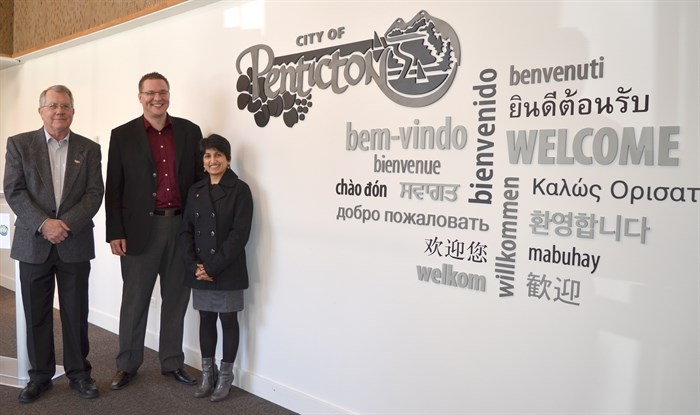
Penticton mayor Andrew Jakubeit, centre, and Tahira Saeed with South Okanagan Immigrant and Community Services, right, are picture with the new welcome wall at city hall, Monday, March 30, 2015.
Image Credit: Contributed
March 30, 2015 - 3:13 PM
PENTICTON - Welcome. Bienvenue. Mabuhay. Benvenuti. Willkommen. Bem-vindo. Welkom.
No matter how you say it, the City of Penticton is proud that City Hall now welcomes the community in multiple languages, as part of a joint partnership program with South Okanagan Immigrant and Community Services to make City Hall more accessible.
“New signs may seem like a small addition to the City Hall space, but they are symbolic and reinforce how welcoming Penticton is for visitors and newcomers alike,” said Penticton Mayor Andrew Jakubeit. “We thank South Okanagan Immigrant and Community Services for devoting time and energy to this project, and making City Hall a more inviting and friendly place to visit.”
City Hall renovations were done in 2014, moving most customer-focused services downstairs to create a one-stop shop on the first floor. Signage had to be updated as a result, and SOICS approached the City about making Penticton’s key civic building more welcoming to new Canadians and individuals who have English as a second language.
“We were excited to be included in the City Hall renovation. It is a central resource location for our newcomer clients and offering a friendly atmosphere is key to their feeling welcome,” said Tahira Saeed, Program Manager for South Okanagan Immigrant and Community Services.
A feature wall in the front lobby of City Hall highlights the word “welcome” in English and 15 different languages: Chinese, Dutch, French, German, Greek, Punjabi, Italian, Japanese, Korean, Portuguese, Russian, Spanish, Tagalog, Thai, and Vietnamese.
International symbols were also used to help customers identify what service they need and recognize what counter provides that service. Wayfinding signage using those symbols and arrows also helps customers identify which direction they need to go, to get to their destination.
New Canadians and immigrants are a key element to resident growth in the South Okanagan, and nurturing their experience in the community is a key economic development strategy for the City of Penticton. Between 2001-2006, the South Okanagan-Similkameen region had 460 new immigrants – representing 26% of the net growth of the region. The area currently receives approximately 100 immigrants per year, and based on general population growth projections, this number is anticipated to double.
South Okanagan Immigrant and Community Services works together with immigrants to help them get settled, find careers and learn all they need to know about starting their new lives in Canada. The multi-lingual staff appreciates the valuable contributions immigrants make to Canada, while also understanding the difficult challenges of settling in a new country. SOICS works with immigrants to help them realize the full potential of their lives in Canada.
How welcoming gestures differ according to culture
The handshake is widely recognized in Canada as a respectful greeting – either to introduce yourself or welcome an individual to your office or home. While people who were raised in Canada likely believe a firm handshake is a sign of confidence that conveys trust and respect, how people are greeted in other countries can be very different:
In Russia, a handshake is rarely performed by opposite sexes. Men shaking hands with women can be considered impolite.
In the Middle East, handshakes are not as firm as in Canada, and a handshake that is too firm will be considered rude.
In Japan, China and the Philippines, a weak handshake is preferred, and people will often hold on to each other’s hands longer.
In India, the “Namaste” gesture combined with a slight bow is used in place of handshakes.
In Brazil, expect a firm handshake that last longer than in Canada. Strong eye contact typically is part of this welcome, too.
In Mexico, expect a long-lasting handshake and, if you are male, maybe a hug. Women may kiss each other on the cheeks.
In Thailand, individuals never shake hands. The person will offer a “wai,” which is placing their palms together at chest level and bowing.
— Welcome gesture information courtesy of South Okanagan Immigrant and Community Services
News from © iNFOnews, 2015